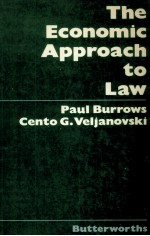图书介绍
THE ECONOMIC APPROACH TO LAWPDF|Epub|txt|kindle电子书版本网盘下载

- PAUL BURROWS 著
- 出版社:
- ISBN:
- 出版时间:1981
- 标注页数:343页
- 文件大小:18MB
- 文件页数:352页
- 主题词:
PDF下载
下载说明
THE ECONOMIC APPROACH TO LAWPDF格式电子书版下载
下载的文件为RAR压缩包。需要使用解压软件进行解压得到PDF格式图书。建议使用BT下载工具Free Download Manager进行下载,简称FDM(免费,没有广告,支持多平台)。本站资源全部打包为BT种子。所以需要使用专业的BT下载软件进行下载。如BitComet qBittorrent uTorrent等BT下载工具。迅雷目前由于本站不是热门资源。不推荐使用!后期资源热门了。安装了迅雷也可以迅雷进行下载!
(文件页数 要大于 标注页数,上中下等多册电子书除外)
注意:本站所有压缩包均有解压码: 点击下载压缩包解压工具
图书目录
1 Introduction: the economic approach to law&Paul Burrows and Cento G. Veljanovski1
1.1 The economic approach to law2
1.2 The benefits and costs of the economic approach13
1.3 Positive economic theories of law—prediction v description17
1.4 Toward an economic approach of the third kind22
1.5 Statutory control25
1.6 Concluding remarks25
Part one Contract35
2 Contract analysis: the transaction cost approach&Oliver E. Williamson39
2.1 Economic approaches to contracting39
2.2 A three-way classification of contracts42
2.3 Transaction cost economics45
2.4 Commercial contracting48
2.5 Other applications55
2.6 Concluding remarks56
3 Economic analysis of contractual relations&Ian R. Macneil61
3.1 Neoclassical microeconomic model, transactions costs and relational contract62
3.2 Discrete transactions and modern contractual relations64
3.3 Neoclassical microeconomic analysis of contractual relations75
3.4 Conclusion85
4 Judicial control of standard form contracts&M.J. Trebilcock and D.N. Dewees93
4.1 Introduction93
4.2 Standard form contracts and monopoly98
4.3 Standard form contracts and information asymmetries104
4.4 Comparative institutional competence116
Part two Tort121
5 The economic theory of tort liability—toward a corrective justice approach&Cento G. Veljanovski125
5.1 Introduction125
5.2 The legal and economic objectives of tort liability126
5.3 A corrective justice framework133
5.4 Some applications140
5.5 Conclusion144
6 Nuisance, legal rules and decentralized decisions: a different view of the cathedral crypt&Paul Burrows151
6.1 Introduction151
6.2 Justice and efficiency defined151
6.3 Tertiary costs, information and general deterrence152
6.4 Criteria for selecting legal rules154
6.5 Conclusion163
7 Negligent misrepresentation: an economic reformulation&William Bishop167
7.1 Introduction167
7.2 Conventional debate168
7.3 Information production and appropriability170
7.4 Two party negligent misrepresentation: transaction costs and quality signalling176
7.5 Three party negligent misrepresentation180
7.6 Public authorities183
7.7 Conclusion184
Part three The judicial process187
8 Economic aspects of legal procedure&Roger A. Bowles191
8.1 Introduction191
8.2 Analytical background192
8.3 Procedural issues197
8.4 Concluding remarks207
9 Quantitative rules and judicial decision making&Anthony I. Ogus210
9.1 Optimal precision of legal rules210
9.2 Trends in judicial rulemaking215
9.3 Conclusions222
10 The plea bargain in England and America: a comparative institutional view&Richard P. Adelstein226
10.1 Criminal price exaction and the development of procedure226
10.2 The negotiated plea in the price exaction framework229
10.3 External aspects of the price exaction procedure: moral cost considerations237
10.4 A direction for further research246
11 Judicial responses to exchange rate instability&Roger A. Bowles and Christopher J. Whelan253
11.1 Introduction253
11.2 The law before 1975254
11.3 The law since 1975256
11.4 Some difficulties259
11.5 Behaviour of defendants265
11.6 Conclusions267
Part four Public law273
12 Landlord-tenant relations law&Werner Z. Hirsch277
12.1 Introduction277
12.2 Habitability laws278
12.3 Rent control laws290
12.4 Just-cause eviction laws295
12.5 Age discrimination laws298
12.6 Conclusions300
13 The law and economics of the misconduct rule of unemployment insurance&Paul T. Fenn307
13.1 Introduction307
13.2 The misconduct rule: objectives and interpretation308
13.3 Dismissal for misconduct: optimizing behaviour where the law is given312
13.4 Disqualification for unemployment benefit as a result of misconduct: some evidence315
13.5 Conclusion318
14 Tax avoidance&J. Feldman and J. A. Kay320
14.1 Introduction320
14.2 Origins of tax avoidance321
14.3 Tax avoidance and the definition of income323
14.4 Tax avoidance in practice325
14.5 Is tax avoidance inevitable?331
Index334